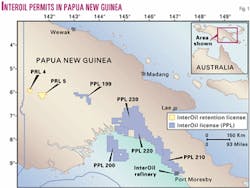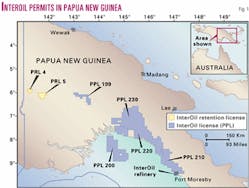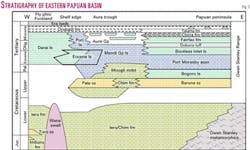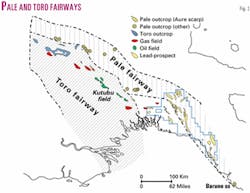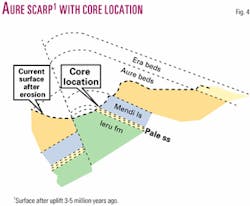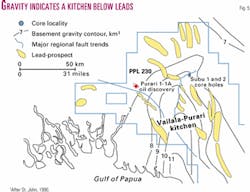InterOil Corp. has discovered a new oil system in the eastern Papuan basin in Papua New Guinea (PNG). With a good quality reservoir sand and two sources of oil, the eastern Papuan basin is now proven to be prospective for oil, with the potential for world class oilfields comparable to Kutubu field (more than 300 million bbl) that has been producing since 1992.
InterOil has been awarded a new license (PPL 230) that includes all the identified Pale sandstone prospects and plans to drill four wells in 2002 and eight in 2003 to test large structures. This new play will revitalize exploration in PNG, which has averaged only two exploration wells per year in recent years.
PNG approach
InterOil is a Canadian entity developing a niche integrated energy company focused initially on PNG. The cornerstone is the construction of a 32,500 b/d refinery in Port Moresby, PNG, designed to run light sweet crude such as the PNG production sold at Kutubu. The refinery will primarily supply PNG domestic demand, with the economics based on both the refinery crack spread and the avoided transport costs of exporting oil and importing products.
InterOil has been exploring for oil in PNG since 1999. The key to the business plan has been to find a way to cost-effectively explore an underexplored frontier area. The implementation of the plan has seen InterOil obtain licenses over areas with good logistics and access to the refinery, and then find tangible evidence of a working petroleum system and identify 30 leads and prospects.
Since the discovery of oil in the Toro sandstone at Kutubu, exploration has concentrated on the Toro sandstone fairway in the fold belt and foreland in western PNG. Kutubu field will produce more than 300 million bbl, and Hides field contains more than 5 tcf. However, a combination of factors including high costs of drilling in the fold belt has reduced exploration to drilling commitment wells.
The eastern Papuan basin had been explored sporadically since 1911. Petro-Canada drilled the last well, Au Tabua, in 1991. The Pale sandstone had been identified as a possible reservoir, but with only a few outcrop samples, the provenance, extent, and reservoir quality were unknown.
When InterOil began to look for exploration opportunities in 1998, the eastern Papuan basin was open acreage except for a few blocks around the Puri-1 oil discovery. InterOil considered the area to be underexplored (as the few wells drilled had not penetrated below the Miocene Aure beds) but with petroleum potential due to numerous oil and gas seeps and the Puri-1 well that flowed 1,610 bo/d.
InterOil in 1999 obtained licenses PPL 208 and 210, stretching from the existing oil pipeline to the refinery at Port Moresby. To balance the exploration portfolio, InterOil sought and obtained low entry cost interests in other permits in PNG. InterOil has interests in PPL 199, PPL 200, PRL 4, and PRL 5 (Fig. 1). PPL 199 is a fold belt license operated by Oil Search Ltd. near the Paua-1 oil discovery and not far from the Bakari-1 well ExxonMobil was drilling in February 2002. PPL 200 is an offshore block operated by Talisman Energy Inc., and PRL 4 and PRL 5 are gas-condensate fields operated by Santos Ltd. with potential access to the refinery via the Fly River.
The initial phase of exploration involved finding, reviewing, reprocessing, and interpreting original data (including gravity and seismic). Together with extensive field work, this has established a portfolio of prospects. This initial work and reports of other Pale sandstone outcrops indicated the Pale could be a regional play extending into open acreage, and InterOil applied for additional license areas.
InterOil in January 2002 was awarded PPL 230, which supersedes or "topfiles" PPL 208. PPL 230 covers 4 million acres and contains all the Pale sandstone prospects identified by InterOil and other play types including the carbonate reservoirs demonstrated by the Puri oil discovery. InterOil has become the largest net onshore acreage holder in PNG and operator with 100% of PPL 230, PPL 220, and 210, which together extend from Port Moresby to the existing oil export pipeline.
Cost-effective progress
InterOil has a core team that works closely together, covering geology, geophysics, engineering, and commercial aspects. This removes any "functional silos" allowing the traditional exploration process to be questioned and innovative concepts to be thought through.
For example, continuous coring of shallow wells provides rock samples that can give direct evidence of porosity, permeability, and hydrocarbons without the cost of casing, logging, or well testing. Industry experience suggests continuous coring is the most cost-effective drilling system for depths to at least 6,000 ft and potentially to 10,000 ft.
By keeping the cost of a well below $1 million, the need to spend time and money on seismic (with a minimum program cost in the order of $2 million) prior to drilling is questionable, especially in an area where the key risk issues are reservoir and charge. While acknowledging wells have been drilled in the wrong places, all of the oil fields in PNG have been found without seismic. Seismic will have a role to play on exploration of deeper structures and in appraisal and development. The InterOil acreage does not have the karst limestone at surface that makes seismic difficult and expensive in the PNG fold belt.
Another way to reduce costs is a multiwell drilling program to gain economies of scale. This requires a portfolio of relatively independent prospects, a low well cost (or a large budget), and a commitment to fully explore a number of higher ranked possibilities rather than a single "roll of the dice" on the best looking prospect. InterOil has identified and plans to drill a range of play types that includes:
- Pale sandstone (cored at Subu-1 and 2).
- Miocene and Eocene carbonates that flowed 1,610 bo/d at Puri-1 and gas at Kuru and Bwata.
- Miocene reefs such as Pasca and Pandora-1 that flowed 50 MMcfd.
- Miocene Chiria conglomerates-clastics that flowed gas at Oroi-1.
- Miocene Talama volcaniclastics that flowed 8,000 bo/d at Iokea-1.
- Pliocene sands that flowed gas at Tovala-1.
InterOil was attracted to areas with logistical advantages of moderate terrain and barge access to infrastructure including the InterOil refinery being constructed in Port Moresby. This will allow early production, lower cost development, and access to a market for oil production. The InterOil coastal acreage has good road and/or river access, allowing lower operating and capital costs for exploration and development. For example, the economic field size for an oilfield near Port Moresby is estimated to be 10 million bbl, compared with 100 million bbl in the fold belt.
Recent exploration
Two InterOil stratigraphic wells cored over 1,600 ft (492 m) with 1,230 ft (375 m) of good reservoir quality "Pale sandstone" (Fig. 2). The estimated true stratigraphic thickness of the Pale is 877 ft (266 m).
Hydrocarbons exist throughout the Pale sandstone. Preliminary analyses suggest these hydrocarbons are bitumen residue of oil that appears to be similar to Kutubu that is believed to be from a Jurassic-source.
A recent field survey found another exposure of Pale sandstone that extends the known width of the Pale fairway (Fig. 3) to more than 40 miles, and a hydrocarbon sample recovered from a fracture that suggests a second (Cretaceous or Tertiary) source. The later source is likely to be still generating oil, increasing the chances of migration into current structures. Both types of crude are light (40-45° gravity) and low sulfur (<0.5%), suitable for processing in the refinery.
The Australian government Commonwealth Science and Industry Research Organisation (CSIRO) is under contract to supply technical and research services. Reports received so far state:
- The key elements of a petroleum system are indicated (reservoir, regional seal, hydrocarbon generation, and charge).
- The reservoir quality of the Pale sandstone is regarded as good. Quantitative tests are still in progress. Initial results indicate porosity up to 16% and horizontal permeability up to 1,700 md.
- The Upper Pale sandstone was deposited in a high-energy marine setting, possibly similar to that in which the Imburu and Toro reservoir sands were deposited.
- The Lower Pale sandstone was probably deposited from turbidites in a shelf-to-basin floor setting, which suggests the sands may be of significant regional extent.
- A pre-Tertiary regional carbonate seal is a possibility in addition to the Tertiary Mendi Group carbonate seal, and the shale unit between the sandstone units is also a potential seal (Fig. 4).
- The hydrocarbons recovered from one sample of the Subu core are similar to produced oils in Iagifu field in the Papuan fold belt, from a Jurassic-source.
- The November 2001 field survey hydrocarbon sample is from a Late Cretaceous or Tertiary terrestrially sourced oil, similar to Gippsland in Australia and Taranaki in New Zealand.
InterOil drilling program
InterOil has identified 12 Pale leads and prospects and 20 other leads and prospects (Fig. 5). The size of these leads and prospects cannot be accurately estimated until further seismic and-or drilling operations are conducted, however large anticlines, seismic, and gravity anomalies have been identified. Future exploration fits in three categories:
- Shallow wells to explore prospects near the Pale outcrop.
- Deeper Pale prospects.
- Other exploration play types including the carbonate reservoirs (as demonstrated by the Puri-1 well) and shallow prospects defined by seismic near Port Moresby.
Initial intentions were to drill one multiwell program, but the opportunity to test large shallow Pale structures has accelerated part of the program to be drilled later this year, with another multiwell program planned for 2003. InterOil plans to conduct in 2002 (subject to PNG government approvals) field surveys, drill at least four shallow wells, and run a seismic survey. Based on experience of the Subu wells, the shallow wells up to 5,000 ft (1,500 m) could be drilled for less than $750,000 (US) each.
The second phase will be additional seismic and an 8 well drilling program, starting later in 2002 or 2003. This program provides a portfolio approach to exploration risk, economy of scale, and accelerates the exploration development time cycle. Using a "fit for purpose" rig will allow the 8 wells to be drilled at a cost estimated to be less than $20 million (US). These cost estimates are comparable with onshore operations in US and Australia and reflect the economies of scale of a multiwell program, the favorable logistics, and a cost efficient approach.
The stratigraphic wells drilled by InterOil demonstrated the ability to effectively conduct operations at low cost and indicate that eastern Papuan basin drilling costs can be a fraction of those in the fold belt.
Oil exploration in PNG
Papua New Guinea is relatively unexplored. Indications of oil since 1911 have resulted in sporadic activity.
Major oil companies joined the search in 1938, and World War II interrupted activity. Gas was discovered when Kuru-1 blew out in 1956, and oil was discovered at Puri-1 in 1957.
Helicopter rigs were required to access the mountainous fold belt, with a high cost structure and lack of commercial success dampening activity until the 8,000 bo/d Iagifu (Kutubu) discovery in 1986, which has been on production since 1992.
Subsequent exploration discovered Gobe and Moran oil fields. Large gas reserves at Kutubu and Hides have seen proposals for liquefied natural gas and a gas pipeline to Australia.
Exploration has fallen to a few wells per year due to a combination of limited success, high operating costs, and an "average" tax regime that includes landowner royalty, and a 22.5% state carried interest.
Exploration success in the InterOil drilling program in the eastern Papuan basin could dramatically revitalize exploration and reverse the decline in PNG oil production.
Bibliography
Carman, George J., "The Stratigraphy of the Aure Scarp, Papua New Guinea," PESA Journal No. 11, September 1987.
Slater, A., and Dekker, F., "An Overview of the Petroleum Geology of the Eastern Papuan Fold Belt, Based on Recent Exploration," in Carman, G.J., and Carman, Z., eds., proceedings of the Second PNG Petroleum Convention, Port Moresby, May 31-June 2, 1993,
The author
Andy Carroll (andy.carroll@ interoil.com) is general manager, exploration and production, InterOil Corp. Before becoming a consultant, he was the PNG and New Zealand manager for Ampolex based in Sydney. Carroll began his career as a drilling engineer for BP and worked in various positions for Dome Petroleum in Canada. He has BA and MA degrees in engineering from Cambridge University.
